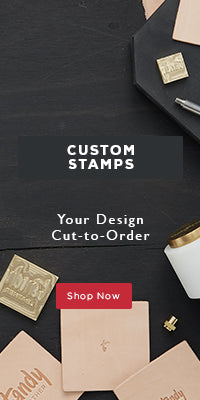All Leathercraft Library patterns and projects are property of Tandy Leather. Projects and patterns available are a part of the Tandy Leather Archive and may contain outdated product information or service offerings. Projects and patterns can be reproduced for personal use by printing, but Tandy Leather cannot guarantee the quality of reproduction or printing due to the image quality available. Some project and pattern themes or motifs may not be representative of Tandy Leather’s current views.

Gift Idea: Traditional Tooling Pattern with The Man in Black

Gift Idea: Traditional Tooling Pattern with The Man in Black

Products:
- Natural Cowhide Leather Belt Blank (SKU 4512-00) QTY: 1
- Heavyweight Veg-Tan Cowhide Strip Natural (SKU 4533-00) QTY: 1
- Selection Quebracho & Chestnut Mix Veg-Tan Side (SKU 9157-58) QTY: 1
- Craftool® Checked Beveler B701 (SKU 6701-00) QTY: 1
- Craftool® Checked Beveler B198 (SKU 6198-00) QTY: 1
- Craftool® Smooth Pear Shader Stamp P703 (SKU 6703-00) QTY: 1
- Craftool® Scalloped & Lined Veiner Stamp V407 (SKU 6407-00) QTY: 1
- Craftool® Lined Veiner Stamp (SKU 6707-00) QTY: 1
- Craftool® Smooth Seeder Stamp S632 (SKU 6632-00) QTY: 1
- Craftool® Flower Center Stamp (SKU 6520-00) QTY: 1
- Craftool® Checked Teardrop Background Stamp A98: Fine (SKU 6098-00) QTY: 1
- Craftool® Checked Teardrop Background Stamp A99: Fine (SKU 6099-00) QTY: 1
- Easy Comfort Swivel Knife (SKU 8002-01) QTY: 1
- TandyPro® Tools Round Head Maul 16 oz. (SKU 3302-11) QTY: 1
- Craftool® Round End Punches 1.5" (SKU 3171-06) QTY: 1
- Craftool® Point End Punches 1.5" (SKU 3172-06) QTY: 1
- Craftool® Heavy Duty Oblong Punches 1" (SKU 3121-04) QTY: 1
- Craftool® Round Drive Punches #6 (3/16") (SKU 3777-06) QTY: 1
- Craftool® Wing Divider (SKU 3607-00) QTY: 1
- 2-in-1 Belt Guide Acrylic Template (SKU 3618-00) QTY: 1
- Leathercraft Sponge Round 2 Pack (SKU 3447-11) QTY: 1
- Dr. Jackson's Pure Neatsfoot Oil (SKU 21997-00) QTY: 1
- Fiebing's Antique Finish 4 fl. oz. (SKU 21980-04) QTY: 1
- Fiebing's Leather Dye 4 fl. oz. (SKU 2400-03) QTY: 1
- Fiebing's Resolene 4 fl. oz. (SKU 2270-01) QTY: 1
- Chicago Screws Solid Brass/Nickel Plate (SKU 1289-06) QTY: 1 (if not using belt with snaps)
- Laramie Buckle 1.5" (SKU 7859-03) QTY: 1
"You only fail when you give up, good luck!" - Bryan Sosack
Instructions:
Sizing Your Belt
Step 1: Take your strapped or Natural Cowhide Leather Belt Blank and mark the rounded belt end of your belt using the 2-in-1 Belt Guide Acrylic Template. (ONLY MARK THE 2 HOLES ON EITHER SIDE OF THE OVAL.)
Step 2: Take your waist size and add 12" from the middle of the oval punch.
Step 3: At the spot where it is 12" + your waist size line up the third from the right hole with your acrylic template and mark the end of your belt.
Step 4: Begin tooling!
Tooling
Step 1: Print out the pattern you're going to use and laminate, or tape over the paper ensuring no wrinkles during this process
Step 2: Wet your leather belt with an ample amount of water using either a sponge or a spray bottle. (User discretion just ensure it's wet enough to tool and not too wet where it becomes difficult)
Step 3: Begin at the end of the belt where your 5 marked holes from earlier are
Step 4: Allow enough space from the end of the belt to use one of the 6 smaller floral designs
Step 5: Place the bigger tooling design on top of the leather and begin tracing the pattern with your stylus onto the leather. (Be sure to leave enough space between each of these sections so you can add flowers, acorns, or cacti!)
- Maker Tip! I personally like to place my belt vertically when tracing the designs. You can also use the longer sections of the design interchangeably if you want more or less of a floral design.
Step 6: Once you finish tracing all of the larger designs pick what smaller ones you want to use and trace those into the spaces you left earlier. (Don't worry if these overlap, we can fix that!)
Step 7: Set your wing dividers to the length on your paper template or close enough where there could be some overlap with the vines/floral
Step 8: Using the wing divider begin tracing down the edge of the belt making sure to not mark over some of the vines/floral that makes it's way into it's path
Step 9: Clean up any areas with your design either following the floral/vine lines to your pattern or picking if the smaller designs will go over or under the larger ones. (Basically just fill in the gaps of your design now)
- Maker Tip! Now's a good time for a break if you need it, but if you'd like to continue be sure to re-wet your belt, it probably needs it!
Step 10: Pick a side of the belt to begin carving into it with your swivel knife and follow it down the belt
- Maker Tip! I start carving closest to the belt buckle end of the belt. And don't be afraid to move your belt around while you use your knife, make it as comfortable as possible for you!
Step 11: As you're carving your design don't feel bad if you happen to move away from the original pattern you traced. Follow the natural curves of your hand and the design!
Step 12: Tape the back of your belt with painter or masking tape to prevent your belt from widening or stretching out while you tool on it
Step 13: Begin beveling out your belt. Start at the foreground or the part closest to you image wise and work your way into the background. (Be sure to notice your background areas and bevel into your previous to have a pronounced lower or background area)
- Maker Tip! I personally am a strong proponent of the textured beveler, I think it holds the stain better but choose whatever one you would like to!
Step 14: On your foremost vine/floral piece you can use a scallop/veiner stamp to add an extra look to the main piece!
Step 15: Now you can go back and use your pear shaders to begin adding more depth to your vines/floral pieces. Start with a harder stamping process working your way where all the vines collect together
Step 16: Use a background stamp in the areas you beveled towards each other earlier to allow for a completed look
Step 17: For a nice more completed look you can come back through with your swivel knife and decorative cuts on your belt
Step 18: Use steps 14 - 17 and repeat for each of the smaller flowers, acorns, or cacti
Step 19: Use a #1 Edge Beveler to round the edges of your belt (inside and outside!)
Step 20: Use Fiebing's Leather Dye 4 fl. oz. Dark Brown with a paint brush on the edges and non-tooled areas of your belt
- Maker Tip! While you could use one cohesive color on your belt I think adding two different colors really makes your belts stand out. (I also wouldn't recommend doing this step if this is your first time working with stain.)
Step 21: Oil both sides your belt using a Round Sponge and Dr. Jackson's Pure Neatsfoot Oil. Start with just enough to cover your belt, you can always add more!
Step 22: Allow the oil to dry
Step 23: Use your other Round Sponge or a cloth with the Medium Brown Fiebing's Antique Finish 4 fl. oz. and rub it over the edges, and back.
Step 24: Grab a cloth and rub it over the back to remove the excess stain.
Step 25: Flip your belt back over and stain the front of your belt ensuring you get every part of your tooled belt.
- Maker Tip! Take this process in chunks instead of the entire belt at once, ensuring you don't let the stain stay too long in each area otherwise it will be slightly darker.
Step 26: Grab a different side of the towel and begin wiping off the excess stain on the front ensuring you're leaving some behind to allow your tooling to pop!
Step 27: Using Fiebing's Resolene 4 fl. oz. add a small amount to a cloth and buff out your belt to take out the leftover stain and seal your belt at the same time
Step 28: Punch out the holes you made at the beginning using the Craftool® Heavy Duty Oblong Punches 1" and the Craftool® Round Drive Punches #6 (3/16")
Step 29: Add your a Buckle of your choice and Chicago Screws to finish off your belt!

|
 |

The Man in Black
As a child, I grew up on a chicken ranch and competed in livestock competitions.
From day one showing livestock- I learned the importance of standing out in a crowd and attention to minor details. With hard work, and a little bit of showmanship I went on to become one of the most decorated youth livestock showmen in southern California history.
When I was young, my mother always made sure we had art supplies in the house and encouraged me to enter my art at the local fairs. My mom always painted pretty flowers or nature scenes, which inspired my love of floral, nature, and the softer more beautiful side of life.
My father was a rough around the edges muscle car guy who spent his time in his garage surrounded by badass hot rod art and posters. Loud music, loud art, and that in-your-face attitude that is so closely associated with classic car culture has heavily influenced my signature style over the years.
During my teenage and college years I worked for my brother in his Saddle shop. I spent years learning how to make high-quality durable ranch goods that were built to last. This foundation of durability and ranch quality leather goods is the starting point of every project I make to this day.
I strive to honor my family legacy- by creating beautiful pieces of leather with a punchy edge that are built to last a lifetime.
Website: https://www.themaninblackleatherstudio.com/
Instagram: @themaninblack







Comments
Leave a comment